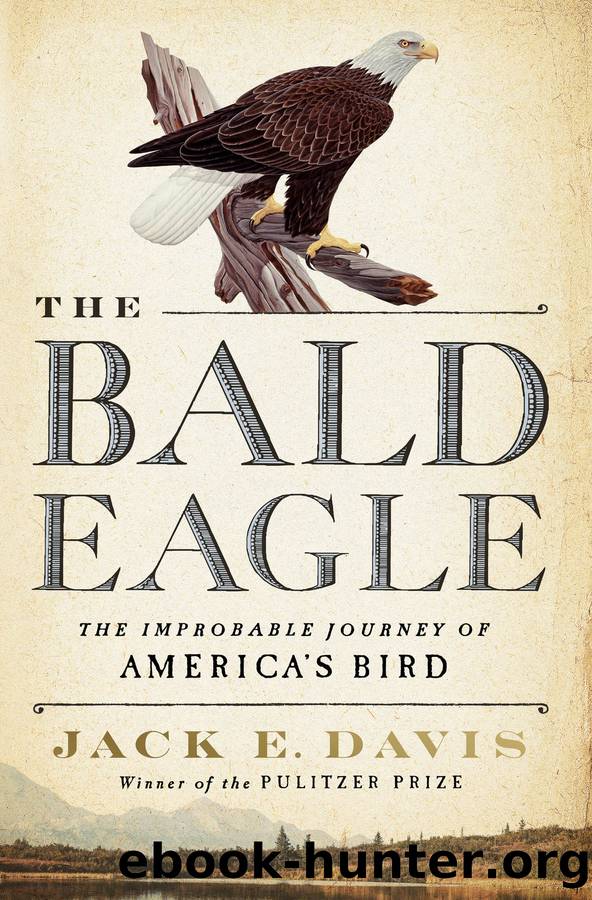The Bald Eagle by Jack E. Davis

Author:Jack E. Davis [Davis, Jack E.]
Language: eng
Format: epub
Published: 2022-01-24T00:00:00+00:00
INCORPORATED AS A US territory in 1912, Alaska was a generally tough place to live for people coming up from the Lower Forty-Eight in the early days. It was cold and faraway, ideally suited for rugged individualists and recluses. A person typically felt the loneliness of oneself standing in its lost-in-the-wilderness vastness. Put the fourteen Atlantic seaboard states next to Alaska, and theyâd be morsels that its mammoth geography could swallow whole, along with a few moreâKentucky, Tennessee, and Alabama.
Alaska was big, and it was biologically and geologically replete. Glaciers and glacier-cut gorges and fjords trimmed and scarred its planetary expanse and erased the modern-calendar meaning of time. Constitutionally conjoined with the rhythms of nature, the nominal father of American conservation, John Muir, who made several curiosity-driven trips to Alaska, wrote, âHow truly wild it is, and how joyously oneâs heart responds to the welcome it gives, its waters and mountains shining and glowing.â Where not frozen, water was restless, tumbling in flumes and sheets down mountainsides and storm-tossed against the rocky coast. Far and near, mountains were always in sight, and rock rubble always at foot. As present as both, deep-shadowed woodlands with scents of the living and recycling dead were both solitude and fright. Large and small creatures foraged in them, as they did out on the tundra and grasslands. Alaska was a province of antlered ungulates (elk, caribou, moose, and black-tailed deer) and antlerless ungulates (Arctic-hoofed musk ox, even-toed bison, mountain goats, and Dall sheep). Wolves and grizzlies moved under the midnight sunâas did birds of prey.31
Charles Keeler, an ornithologist and poet, who was part of an 1899 Alaskan coastal expedition, which Grinnell and Burroughs joined, wrote that the bald eagle âmakes a striking pictureâ that âseems peculiarly in keeping with the grandeur of the scenery and the solitude of these wave-washed shores.â Millennia before early Homo sapiens crossed the Bering Land Bridge, bald eagles experienced Alaskaâs steadfast generosity in its rivers and seas. From the fish eaterâs perspective, nothing was more profuse and clockwork dependable than Pacific herring and salmon. Every spring and summer spawning run was for bald eagles the equivalent of a Klondike gold rush, except the runs were perennial, and each delivered a mother lode to every prospecting eagle. Muir described the Alaskan raptor as âheavy-looking and overfed, gazing stupidly like gorged vultures.â32
Eventually, their pescatarian proclivities got them into trouble after people with commercial proclivities began showing up in Alaska. When the US purchased the territory from the Russians in 1867âwith gold in the hills, timber in the woods, furbearers on the land, blubbery and pelted mammals in the sea, and fish in salt- and freshwatersâthe corresponding extractive industries already had the run of the place. Bald eagles soon would not. As they were to the livestock farmer down in the Lower Forty-Eight, they were to the salmon and herring fisher, fox-fur trader, and sheepherder in Alaska. âThere is no agency more destructive to the fish and game of this country,â an Alaskan wrote in a letter to the New York Times in 1920, âthan the American eagle.
Download
This site does not store any files on its server. We only index and link to content provided by other sites. Please contact the content providers to delete copyright contents if any and email us, we'll remove relevant links or contents immediately.
Machine Learning at Scale with H2O by Gregory Keys | David Whiting(4184)
Never by Ken Follett(3794)
Harry Potter and the Goblet Of Fire by J.K. Rowling(3775)
Unfinished: A Memoir by Priyanka Chopra Jonas(3333)
Fairy Tale by Stephen King(3220)
The Man Who Died Twice by Richard Osman(2997)
Will by Will Smith(2793)
Rationality by Steven Pinker(2291)
The Dark Hours by Michael Connelly(2245)
Can't Hurt Me: Master Your Mind and Defy the Odds - Clean Edition by David Goggins(2228)
It Starts With Us (It Ends with Us #2) by Colleen Hoover(2198)
The Storyteller by Dave Grohl(2172)
The Dawn of Everything: A New History of Humanity by David Graeber & David Wengrow(2122)
Friends, Lovers, and the Big Terrible Thing by Matthew Perry(2119)
The Becoming by Nora Roberts(2088)
The Stranger in the Lifeboat by Mitch Albom(2050)
Cloud Cuckoo Land by Anthony Doerr(2035)
Einstein: His Life and Universe by Walter Isaacson(1967)
Love on the Brain by Ali Hazelwood(1965)
